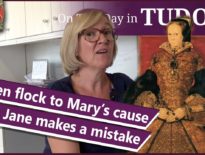On this day in history, 11th July 1553, in Ipswich, Suffolk, Sir Thomas Cornwallis, sheriff of Norfolk and Suffolk, Lord Thomas Wentworth, and some other prominent Suffolk gentlemen declared for Queen Jane (Lady Jane Grey) and publicly proclaimed her the rightful queen. However, the following day, Cornwallis recanted and proclaimed Mary as queen.
Why? What happened to make this sheriff change his mind so soon?
Find out more about the situation in July 1553 in today's talk.
Also on this day in Tudor history, 11th July 1533, Pope Clement VII had had enough of the misbehaving King Henry VIII. But how had this English king gone from being lauded as Defender of the Faith to now being threatened with excommunication? What had he done to upset the Pope? Find out in last year’s video:
Also on this day in history:
- 1536 – Death of Desiderius Erasmus, the famous Humanist scholar, from dysentery at Basel during the night of the 11th/12th July. He was buried in the cathedral at Basel on 18th July. His works included Novum Instrumentum omne (a Latin translation of the epistles and gospel), “The Praise of Folly,” “De Copia”, “Adagia” and “The Education of a Christian Prince”.
- 1558 – Baptism of Robert Greene, writer and playwright, at St George's Church, Tombland, Norwich. His works included the plays “The Scottish History of James IV” and “Friar Bacon and Friar Bungay”, and the romance “Mamillia”.
- 1564 – The plague hit Stratford-upon-Avon in Warwickshire. The epidemic lasted six months and killed over 200 people, around a fifth of the population. William Shakespeare was born in April of that year, and his family were fortunate in escaping the plague.
Transcript:
Today, I’m taking you back to July 1553, the month of three Tudor monarchs, a king and two queens.
The boy-king, fifteen-year-old King Edward VI had died on 6th July 1553 and had named Lady Jane Grey, the daughter of his cousin, Frances Grey (née Brandon), Duchess of Suffolk, as his heir. His half sisters, Mary and Elizabeth, had been made illegitimate by Acts of Parliament during his father Henry VIII’s reign, and although Henry VIII had added them back into the line of succession before he died, Edward did not view them as eligible claimants, writing in his devise for the succession that “the said Lady Mary, as also the said Lady Elizabeth, to all intents and purposes are and be clearly disabled to ask, claim, or challenge the said imperial crown”, as well as to any of his property, and pointing out that they were “half blood”. Whereas Lady Jane Grey was legitimate.
If you’ve listened to my talk from 9th July, you’ll know that on that day in 1553, Jane was told that she was queen and although she was distressed by news of Edward’s death and didn’t seek the crown, once she found out that it was what Edward wanted, she accepted the crown as her destiny, as God’s plan for her. In the meantime, Edward’s half-sister, Mary, wrote to the Privy Council stating that she was the rightful queen and demanding their allegiance.
On 10th July, Jane was proclaimed queen in London and on this day in history, 11th July 1553, in Ipswich, Suffolk, Sir Thomas Cornwallis, Lord Thomas Wentworth, and some other prominent Suffolk gentlemen declared for Queen Jane. According to contemporary Robert Wingfield, of the prominent Suffolk Wingfield family, Cornwallis, who was sheriff of Norfolk and Suffolk, and a man who’d served as steward in Edward VI’s houshold before he was king, had received instructions from Lady Jane Grey’s father-in-law and the leader of the late king’s government, John Dudley, Duke of Northumberland. According to Northumberland, Cornwallis was “to make public with all haste the news of the king’s death and to proclaim Jane as the new queen in the counties. Cornwallis, Wentworth and the other important man gathered in Ipswich “and earnestly discussed the perils of the situation” and decided to follow the instructions and proclaim Jane as queen, which they did on 11th July, but “not without murmurs of discontent and great indignation from the common people.”
Wingfield goes on to write of how while they were still there, Mary's receiver, Thomas Poley, came to the marketplace on Mary’s orders and proclaimed his mistress “hereditary queen of England”. He then quickly left, for fear that he and his men would get into trouble. However, his proclamation, which had been well-received by the townsfolk, made Cornwallis think twice about his support for Jane’s claim. According to Wingfield, he then set off for London “to seek advice from the most illustrious men of the kingdom” and on the way met John Colby, a good friend who had been in London and who reported that “the people of London were very ill-deposed to Norhumberland and the great men of the realm for disinheriting Mary, and that everything there pointed to violence and an uprising.” On hearing this, Cornwallis, accompanied by Colby, returned to Ipswich, and, the following day, “amid scenes of general enthusiasm”, recanted his previous proclamation and proclaimed Mary as “the true and undoubted heir to the throne”.
On 19th July 1553, Jane’s short reign as queen was over when Mary was proclaimed queen in London.



Leave a Reply